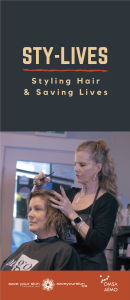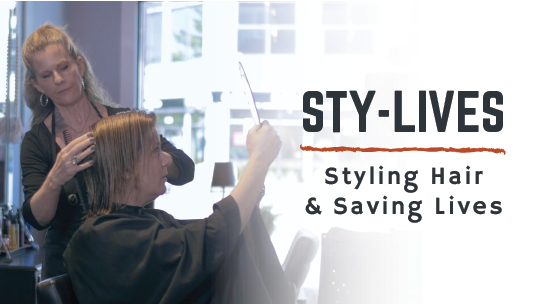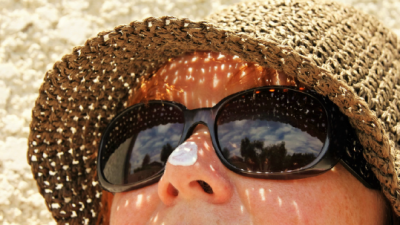Every May is not only Melanoma Awareness Month, but also the beginning of sunny weather and summer plans. This year, while we are sheltering in place, going to the park or for a walk can be a great way to improve your mood; however, it is important to make sure that you are not only socially distancing, but also taking sun safety measures.
In 2019, the Canadian Cancer Society estimated that of the 220,400 new cancer cases in 2019, 7,800 were melanoma (p. 25). Melanoma counts for 7% of cancer diagnoses for both the youth/young adult (15-29) and adult (30-49) demographics, as per a distribution of new cancer cases (for selected cancers) by age group in Canada (excluding Quebec), in 2011-2015 (p. 14). While the incidence rates for melanoma are not as high as other types of cancer, the mortality rates are substantial: of the 82,100 projected cancer deaths in 2019, 1,300 are expected to be due to melanoma (p. 47). Therefore, it is important to be vigilant in protecting yourself when you are outside in the sun, even if it is a quick trip.
It is true that certain populations are more at risk of developing skin cancer, such as those who have skin cancer in their family, are fair-skinned, or are taking any medication that may suppress their immune system; however, anyone who had frequent or extreme sunburns in adolescence, or continues to spend prolonged, unprotected time in the sun, is dramatically increasing their risk of developing skin cancer, as every sunburn is indicative of skin damage. While some of these circumstances are unavoidable, it is possible to reduce your risk of skin cancer by taking the following precautionary measures while enjoying your time in the sun. We encourage you to share these tips with your friends and family by sharing our Sun Safety Awareness Resources page, which has links to several helpful online and print guides to sun safety and skin cancer awareness.
Prevention
The most important sun safety tip is to limit your exposure to it. Enjoy the outdoors, but take these precautions:


Sunscreen is also your ally. Here are some tips:
- Carry a travel-sized sunscreen and an SPF lip balm with you at all times, so you are always prepared
- Get a sunscreen that is at least SPF 30 and offers UVA and UVB protection
- Apply your sunscreen 20 minutes before going out in the sun
- Reapply your sunscreen every two hours
- Cream or lotion-based sunscreens provide better coverage than sprays
- Make a list of the places you often forget, and cover them first– often-forgotten spots include the tops of feet, backs of hands, neck and ears
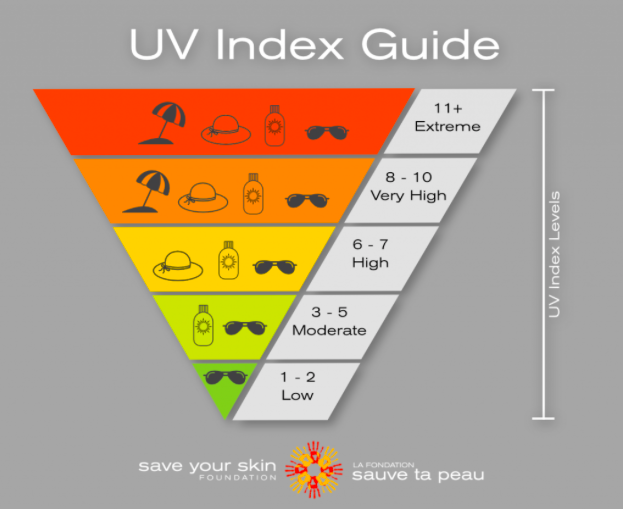
Before going out, don’t forget to consult the UV Index rating in your area. You can also download UV Index apps such as the UV Index Widget or the Wolfram Sun Exposure Reference App. Use guide above to help you interpret UV ratings.
Detection
Throughout the year, it is important to give yourself a self skin-check once a month. If you have a partner, perform them for each other. Take photos of, or write down, any existing moles, so you have a reference in case of any changes. To ensure that you do not miss a spot, visit the Skin Cancer Foundation guide to self-exams. If you see any changes in a mole, any new growths or moles, or you develop a sore that does not heal, get in touch with your health practitioner as soon as possible– it never hurts to be cautious, and earlier detection means earlier treatment.
When checking your own skin or that of your loved ones, keep in mind the “ABCDEFG’s” of skin checks:
- A – Asymmetry. The shape of one half does not match the other half.
- B – Border that is irregular. The edges are often ragged, notched, or blurred in outline. The pigment may spread into the surrounding skin.
- C – Colour that is uneven. Shades of black, brown, and tan may be present. Areas of white, grey, red, pink, or blue may also be seen.
- D – Diameter. There is a change in size, usually an increase. Melanomas can be tiny, but most are larger than 6 millimeters wide (about 1/4 inch wide).
- E – Evolving. The mole has changed over the past few weeks or months.
- F – Firm. Is the mole harder than the surrounding skin?
- G – Growing. Is the mole gradually getting larger?
While checking your skin for moles, you should also be keeping an eye out for actinic keratosis, also known as solar keratosis. Actinic keratosis generally develops in older people on sun-exposed areas of the skin. Actinic keratosis feels like a rough patch on the skin, and may become visible as red scaly patches; it is often confused with eczema. It may feel tender to the touch. If left untreated, actinic keratosis may develop into squamous cell carcinoma.
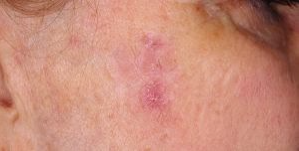
(“Actinic Keratosis.” Scars Center.)
When you are spending time outside this summer, do not forget to take sun safety precautions. Stay safe out there!
